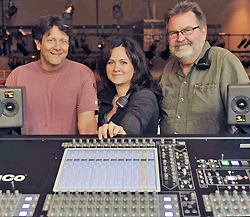
The core of Union Station is a 5-piece band featuring Dobro phenom Jerry Douglas, with the addition of a drummer and a keyboardist for this tour.
Miller’s utilizing approximately 34 inputs for the band, much of which is dedicated to a band-wide package of Shure microphones for drums, fiddle, guitars, banjo, lap steel amp and vocals, a Neumann TLM 193 on the bass cab, as well as Fishman Aura DI’s for guitar, banjos and Dobro [the Jerry Douglas signature model], and various inputs for playback iPod, et cetera.
A nightly encore finds the group singing in old-timey fashion gathered around a Shure KSM44.
Miller’s output section is fairly minimal, comprised of Left and Right outs, with the occasional Left Right Upper and Left Right Lower.
“I always have a Left/Right, side fill, front fill, delay mix, and always provide an ADA house mix for the hearing impaired,” he notes. “One is dedicated for my Smaart computer. It’s an industry-wide reference software package that I use for tuning the sound system into the room environment itself, and for PA time alignment. It’s invaluable and I use it every day… very affordable, very versatile and it really fills a niche for me.”
Within the console, Miller’s effects rack is minimal, consisting of about four reverbs and two delays. “I’m using the simple vocal plate for Alison’s vocal and the backup vocals, and a simple delay that I use mainly for the Dobro to get a pan effect in some of the slower songs that we do. Other various reverbs I use are for percussion, and I have a warm hall delay that I use on guitars. Obviously in an auditorium, a little reverb on the instruments is always nice. It’s a pretty basic setup because, after having worked with them for 11 years, I try to be as true to the instrument’s sound—and to the recordings—as possible. The music they play has a wide dynamic range, and I like to make the most use out of that, so there’s very little compression.”
Marcos and snapshots are two of the must-have features for Miller’s daily workflow. “I like being able to record a macro of an EQ setting that I can use for one particular instrument in one particular song. Typically, I have my console set up so when I have an EQ for a guitar it stays the same through all the snapshots. But when they change instruments using the same line, using the macros I can bring up the EQ I prefer when, say, Ron plays the Banjola on ‘Sinking Stone,’ which is a radically different EQ then I use for his guitar on another song. It’s very simple for me at FOH to be able to recall what I need quickly.
“I also have an ADK Lyve Tracker digital workstation recording 56 channels at 96K to create a ‘virtual soundcheck’. The SD-10 outputs MADI to Lyve Tracker and at the bottom of the playlist I have a playback snapshot for recalling the output from the Lyve Tracker to the inputs of the console for playback. I’m also using Time Fade a bit between songs, where they go from one song right into another. I can use that to ease in the drums and other instruments and it works very nice. I can just hit the scene and let it transition.”
The SD10 at monitor world is set up and shared for Haley Miller and Bernie Velluti to manage their respective areas—Haley for Alison specifically, and Bernie for the rest of the band.
“I set the console up and layered it so I have all my channels on one side of the board and Bernie can have the other side for his,” Haley Miller says. “This worked well for us, and it was great to have two sets of eyes on the band at all times. I love the versatility of the board. Being the first time on a DiGiCo, I found it seemed almost limitless in how I could customize the console to my specific needs. The rotary knobs are assignable.
“For example I’m able to bring my head amp, high pass filter and Pan control right above my channel fader. Within a push of a button the rotary knobs toggle between my settings and Aux sends. The best feature for me, though, is the ability to control the surface offline, although it will get you in trouble if you are not careful. We have a scene for every song and everyday there are some variances in instrumentation, such as proximity of the subs, it changes day to day and affects the level of bass that is put in the ears.
“As well as pedal boards, they are never the same, even when you mark every knob. Making the appropriate adjustments for these channels has been so easy. Without interrupting audio within the current scene, I’m able to take the surface offline, fire any scene make changes, save and return to audio before the song ends. If I need to make the same change in all or just select scenes, I can edit Range, make the change and confirm it within all the ones selected.
“I’ve really enjoyed working with this console and it will be difficult to jump back on something else when we get back into the shop. The clarity is there for Alison, who is using the Sensaphonics 2Max earbuds with a Shure PSM 900 belt pack. She has told me, ‘It’s so clear and full’. You can really gain it up and it has such a nice fluid transition.”
